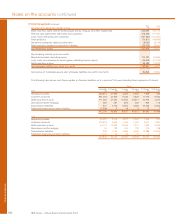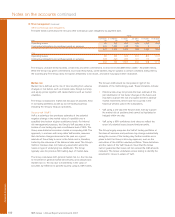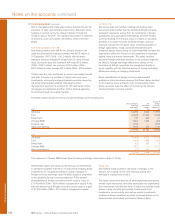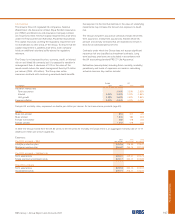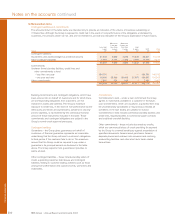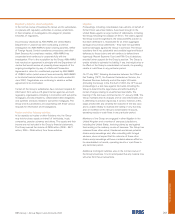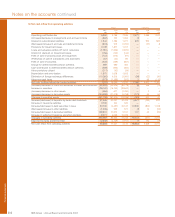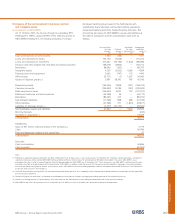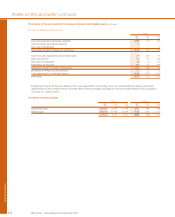RBS 2007 Annual Report Download - page 198
Download and view the complete annual report
Please find page 198 of the 2007 RBS annual report below. You can navigate through the pages in the report by either clicking on the pages listed below, or by using the keyword search tool below to find specific information within the annual report.
Financial statements
RBS Group • Annual Report and Accounts 2007
196
Notes on the accounts continued
31 Risk management (continued)
2007 2006 2005
Earned Claims Loss Earned Loss Earned Loss
premiums incurred ratio premiums ratio premiums ratio
£m £m % £m % £m %
Residential property Gross 1,087 894 82 1,121 56 1,098 55
Net 1,020 878 86 1,061 59 1,037 56
Personal motor Gross 3,254 2,616 80 3,384 84 3,312 79
Net 3,161 2,560 81 3,279 85 3,257 80
Commercial property Gross 211 116 55 218 37 212 39
Net 191 115 60 198 38 193 40
Commercial motor Gross 142 107 75 90 69 102 53
Net 133 107 80 88 68 96 46
Other Gross 851 337 40 842 47 853 63
Net 839 340 41 833 49 761 67
Total Gross 5,545 4,070 73 5,655 71 5,577 70
Net 5,344 4,000 75 5,459 73 5,344 71
The Group has no interest rate exposure from general insurance liabilities because provisions for claims under short-term insurance
contracts are not discounted.
Claims reserves
It is the Group’s policy to hold undiscounted claims reserves
(including reserves to cover claims which have been incurred
but not reported (IBNR reserves)) for all classes at a sufficient
level to meet all liabilities as they fall due.
The Group’s focus is on high volume and relatively
straightforward products, for example home and motor. This
facilitates the generation of comprehensive underwriting and
claims data, which are used to accurately price and monitor
the risks accepted.
The following table indicates the diversity of risks underwritten
and the corresponding loss ratios for each major class of
business, gross and net of reinsurance.
Frequency and severity of specific risks and
sources of uncertainty
Most general insurance contracts are written on an annual
basis, which means that the Group’s liability extends for a 12
month period, after which the Group is entitled to decline or
renew or can impose renewal terms by amending the
premium, terms and conditions, or both.
The frequency and severity of claims and the sources of
uncertainty for the key classes that the Group is exposed
to are as follows:
a) Motor insurance contracts (private and commercial)
Claims experience is quite variable, due to a wide range
of factors, but the principal ones are age, sex and driving
experience of the driver, type and nature of vehicle, use of
vehicle and area.
There are many sources of uncertainty that will affect the
Group’s experience under motor insurance, including
operational risk, reserving risk, premium rates not matching
claims inflation rates, the weather, the social, economic and
legislative environment and reinsurance failure risk.
b) Property insurance contracts (residential and commercial)
The major causes of claims for property insurance are
theft, flood, escape of water, fire, storm, subsidence and
various types of accidental damage.
The major source of uncertainty in the Group’s property
accounts is the volatility of weather. Weather in the UK can
affect most of the above perils. Over a longer period, the
strength of the economy is also a factor.
c) Other commercial insurance contracts
Other commercial claims come mainly from business
interruption and loss arising from the negligence of the
insured (liability insurance). Business interruption losses
come from the loss of income, revenue and/or profit as a
result of property damage claims. Liability insurance
includes employers liability and public/products liability.
Liability insurance is written on an occurrence basis, and is
subject to claims that are identified over a substantial
period of time, but where the loss event occurred during
the life of the policy.
Fluctuations in the social and economic climate are a
source of uncertainty in the Group’s business interruption
and general liability accounts. Other sources of uncertainty
are changes in the law, or its interpretation, and reserving
risk. Other uncertainties are significant events (for example
terrorist attacks) and any emerging new heads of damage
or types of claim that are not envisaged when the policy is
written.






